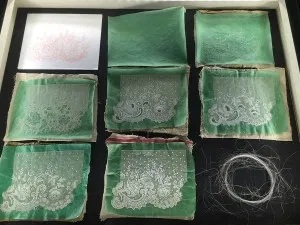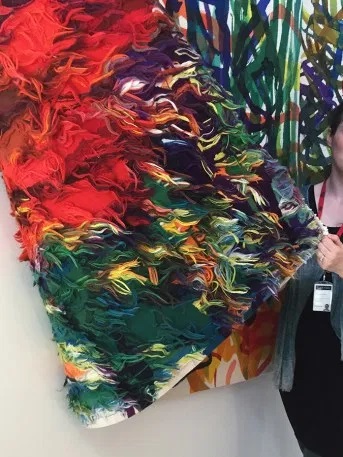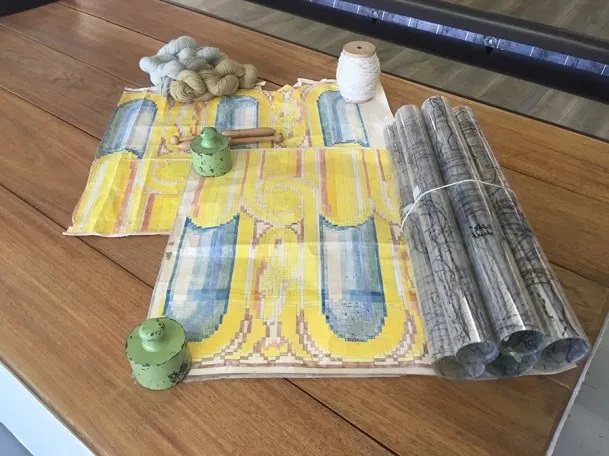Summer Research Report: Sarah Grandin

Sarah in front of a loom, on which a design from Louis XIV’s reign is being recreated at the Savonnerie Carpet Manufacturer in Lodève. Photo courtesy Sarah Grandin.
This past summer, the Trust received an unprecedented number of Summer Research Grant Applications, and had the opportunity to award eight grants—a new record for us! Our summer research scholars all had busy and fruitful summers, and we will be introducing these emerging scholars to the membership over the next few months through our blog and magazine.
Sarah Grandin, a PhD candidate in Art History at Harvard, studies how Louis XIV harnessed the decorative and fine arts to demonstrate his absolute political and material power at Versailles. The key of this propaganda campaign, however, was the skill and mastery of the artisans and craftsmen who are often left out of the historical and academic narrative. It was their own abilities and control over the materials that made Louis’s narrative possible.
Sarah’s background includes a BA in Art History from Stanford University, a stint as a Fulbright Research Fellow studying the development of French gastronomic guides (in the interests of full disclosure, she and Christian were in the same cohort of research fellows), and culinary training. While writing her PhD, she is living in France with her husband, a chef by profession, and two Brittany pointers.
“Thanks to the generosity of the Decorative Arts Trust, I was able to observe the production of Alençon lace, Savonnerie carpets, and Gobelins and Beauvais tapestries in national workshops throughout France this summer. Given that artisans at these ateliers employ manual techniques almost identical to those used when the manufactories were founded in the seventeenth century, I have gained a better understanding of early modern textile production by watching them work. Such insight is essential to my dissertation, which suggests that artisanal operations that preserved or shifted the scale of images across mediums were essential to the projection of Louis XIV’s grandeur.

A vitrine at the Musée des beaux-arts et de la dentelle in Alençon plots out the eight steps of designing and executing a style of handmade lace that dates back to the seventeenth century.
“In my visits to the ateliers of the Manufactures Nationales this summer, a word resurfaced across workshop vocabularies: “réseau.” In common French parlance, this word means “network.” In the realm of the fiber arts, it refers to the actual grid-like net of thread that forms the constitutive tissue of these products. The réseau is made differently in each medium. In lace making, individually stitched loops form the net ground, and the equal size of these loops—and thus the integrity of the plane on which motifs are built—is dependent on the lace maker’s maintenance of equal tension in her thread. The demonstrator at the Alençon lace museum described the shape of each lace maker’s loop as a sort of identifiable handwriting. This description has inspired me to think more critically about the co-presence of regularity and irregularity in craft objects.
“In the case of Beauvais basse lisse and Gobelins haute lisse tapestry weaving, the first step in the construction of the tapestry is the tying of the white, vertical wool warp threads, across which the colored wool weft threads are passed horizontally to render an image. It is essential that these warp threads be tied at perfectly equal distances, at a density of about six threads per centimeter. No rulers are employed; the “licier” uses her eyes and fingers to gauge the regular intervals. This establishment of the matrix of the wool warp threads is also the first step in making Savonnerie carpets, though in this case, weft threads are in ecru linen. What brings color to the carpet are the individual knots tied at the intersection of the warp and weft. As with the lace maker’s réseau and the setting of the warp threads, the regularity of the knots requires an ingrained dexterity. The flick of the weaver’s wrist must cast the perfect and equal amount of wool thread from the bobbin for each knot.
“These artisans possess a unique kinesthetic intelligence, and the precision with which they set down and maintain a regular network rivals mechanical processes. At the same time, their work demands the creativity of translation. They must sensitively interpret cartoons in mediums that are not undergirded by grids, such as drawings, paintings, and watercolors. Each textile practice has a different set of interpretive capacities and restrictions based on its tools and materials. For example, Savonnerie carpets must interpret images knot by knot in a mode that predates digital pixels. To try and hide this “pixelation,” the weavers manipulate the velour or height of the shorn knots to modulate light and shade, to overcome the impossibility of continuous oblique lines, and to blur harsh tonal juxtapositions. This trimming is all done by hand with scissors, which the licier sharpens herself.
The tour guide of the Gobelins Manufacturer in Paris reveals the backside of a contemporary Beauvais tapestry enlarging a bright, abstract watercolor. Photo courtesy Sarah Grandin.
“An eye for color matching is also an essential skill in this métier. When tapestry and carpet weavers first set out to interpret a cartoon, they must test and choose the color of threads they will employ throughout the project, which will take years depending on its size. Artisans have a choice of thousands of different colored threads, all of which are still dyed at the Gobelins laboratory in Paris. Once they have chosen the colors that correspond to their master image, they must submit an order called the “kilotage,” which is their estimate for the weight of each color of thread they anticipate needing. Doing this at the outset allows weavers to maintain the desired regularity of color throughout the textile.
“The purpose of my trip was to better understand how artisanal techniques in the fiber arts allowed for the controlled interpretation of images and motifs across mediums and scales. While the political régime of contemporary France little resembles that of Louis XIV (thankfully these government-employed artisans have a 35-hour work week!), the political role these carpets and tapestries play is not dissimilar to that of their Ancien Régime antecedents. These graphic objects propagate designs by renowned contemporary artists and grace the walls and floors of French civic buildings and embassies the world over. Moreover, the regular nets these men and women weave allow for the execution of works of impeccable quality and artistic merit, whose fine surfaces materially embody years of work and thousands of hours of labor. The artisans who create these carpets, tapestries and lace sustain French patrimony, creating material connections between the past and present, weaving not only spatial but also temporal networks that extend and project a long legacy of artistic glory.”
We’re thrilled with Sarah’s project, and look forward to hearing about future discoveries and observations. We also wish to thank the many generous donors who, over the years, have funded our Summer Research Grants that allow us to support emerging scholars and professionals such as Sarah.
About The Decorative Arts Trust Bulletin
Formerly known as the "blog,” the Bulletin features new research and scholarship, travelogues, book reviews, and museum and gallery exhibitions. The Bulletin complements The Magazine of the Decorative Arts Trust, our biannual members publication.









